高中英语语法代词
英语中的代词

英语中的代词英语中的代词英语作为一种广泛使用的语言,其中一个重要的语法范畴是代词。
代词在英语中起着重要的作用,它们在句子中代表了已经提到的人、物或事情。
这些代词通常用于简化句子结构,并使文本更加流畅。
在英语中,代词通常用于替代已经提到的事物,以避免重复。
它们可以替代名词、名词短语,甚至整个句子。
通过使用代词,我们可以更有效地传达我们的意思,同时使我们的文本不显得冗长。
英语中的代词有很多种,以下是一些主要的代词类型:1、人称代词:这是用来代替人的代词。
例如,我(I)、你(you)、他(he)、她(she)、它(it)、我们(we)、他们(they)。
2、指示代词:这些代词用于表示特定的对象。
例如,这个(this)、那个(that)、这些(these)、那些(those)。
3、疑问代词:这些代词用于提问中,用于询问人、物或事情。
例如,谁(who)、什么(what)、哪里(where)、何时(when)、怎样(how)。
4、关系代词:这些代词用于引导从句,并表示从句与主句之间的关系。
例如,谁(who)、什么(what)、哪里(where)、何时(when)、怎样(how)。
5、不定代词:这些代词用于表示不确定的或未知的人、物或事情。
例如,一个(a)、一些(some)、任何(any)、每个人(everyone)。
正确地使用代词可以帮助我们创建清晰、易于理解的文本。
也需要注意不要误用或错用代词,以免引起混淆或误解。
总的来说,英语中的代词是一个重要的语言工具,可以帮助我们更好地表达自己的意思。
小学英语语法代词小学英语语法代词:介绍、用法和注意事项在英语学习过程中,代词起着非常重要的作用。
尤其是对于小学生,掌握代词的用法能够更好地理解和运用英语。
本文将为大家介绍小学英语语法中的代词,包括其特点、用法和注意事项,以帮助孩子们更准确地使用英语。
一、代词的种类和特点在小学英语语法中,常见的代词有:人称代词、物主代词、反身代词、指示代词和不定代词等。
代词知识点总结高中

代词知识点总结高中代词是指用来代替名词或名词短语的词语,可以分为人称代词、指示代词、疑问代词、关系代词、不定代词等。
代词在句子中起着替代名词的作用,能够使句子更加简洁明了。
在高中的语法知识中,代词是一个非常重要的部分,它的正确使用对于学生们的英语学习至关重要。
下面将对代词的相关知识进行总结和归纳,希望能够帮助同学们更好地掌握代词的用法,提高语言表达的准确性和流畅性。
一、人称代词人称代词是用来表示人的称谓或指示人的词语,包括主格、宾格、和所有格等不同形式。
在英语中,人称代词的变化比较丰富,需要根据不同的语境和功能来灵活运用。
人称代词的主要形式包括:I, you, he, she, it, we, they等。
1. 主格人称代词主格人称代词用来作为主语,表示发出动作或起作用的人或物。
例如:I am a student. You are my friend.2. 宾格人称代词宾格人称代词用来作为宾语,表示受动作的人或物。
例如:She gave it to me.3. 所有格人称代词所有格人称代词用来表示所有关系,通常用来修饰名词。
例如:This is my book. That is your pen.二、指示代词指示代词是用来表示事物位置、方向、程度或数量等的代词,常见的指示代词有this, that, these, those等。
1. this和thatthis表示离说话人近的事物,that表示离说话人远的事物。
例如:This is my bag. That is her umbrella.2. these和thosethese是this的复数形式,表示离说话人近的事物;those是that的复数形式,表示离说话人远的事物。
例如:These are my shoes. Those are his socks.三、疑问代词疑问代词用来提问人、事、物的名称或数量,包括who, what, which, whose, whom等。
高中英语语法知识——代词

高中英语语法知识——代词英语中的代词,按其意义、特征及在句中的作用分为九种:人称代词分为主格(如:I, you, he等)和宾格(如:me, you, him)物主代词分为形容性物主代词(如:my, his, your)和名词性物主代词(如:mine, his, yours)指示代词常见的有四个:this这,that那, these这些, those那些反身代词如:myself我自己,himself他自己,themselves他们自己疑问代词用在特殊疑问句中。
有:who, whom, whose, what, which。
如:Who is that boy? What do you like?不定代词如:some一些, many许多, both两个都, everything, everybody等关系代词引导定语从句。
如:This is the boy who won the race.相互代词指each other 与one another,意为“互相”连接代词疑问代词在引导从句时,都称为连接代词,包括who, whom, whose, what, which, whoever,whomever, whichever, whatever,一共九个。
如:It is clear enough what she meant. 她是什么意思很清楚。
(引导主语从句)I don’t care what they think. 他们怎么想我不管。
(引导宾语从句)第1讲人称代词第2讲指示代词人称代词分为主格和宾格。
考点1. 代词作同位语如果代词和名词指代相同时,常用主格或宾格作同位语,不用物主代词。
改错:Our Chinese people are friendly. 把our改为we, 因为我们本身就是中国人。
考点2. 用人称代词宾格代替主格的情况①口语中作表语的人称代词一般用宾格,不用主格。
—Who is it? —It’s me.②在比较句型中,as和than后的主格可以用宾格代替。
高中语法专题 代词

代词人称代词:I, you, he, she, we, they, me, him, her….物主代词:my, your, mine, yours, their, theirs, its…反身代词:myself, himself, ourselves, itself…相互代词:each other, one another指示代词:this, that, these, those疑问代词:who, whom, whose, what, which…关系代词:who, whom, whose, which…连接代词:who, whom, whose, which不定代词:all, both, one, some, few, either, any, other, another, many, none…一、人称代词主格:I, you, she, he, their, we宾格: me, you, her, him, their, us(1) 宾格代替主格a.在简短对话中,当人称代词单独使用或在not 后,多用宾语。
---- I like English. --我喜欢英语。
---- Me too. --我也喜欢。
---- Have more wine? --再来点酒喝吗?---- Not me. --我可不要了。
b.在比较级的句子中than、as后用主格、宾格都可以 ,如:He is taller than I/me.但在下列句中有区别:I like Jack as much as her.=I like both Jack and her.I like Jack as much as she.=I like Jack and she likes him, too(2)两个以上的人称代词并列,其次序排列原则:在并列主语中,“I”总是放在最后,排列顺序为:二三一(人称)。
宾格me也一样。
You ,she and I will be in charge of the caseMr.Zhang asked Li Hua and me to help him(3)几个人称代词的特殊用法。
高中英语语法总结大全
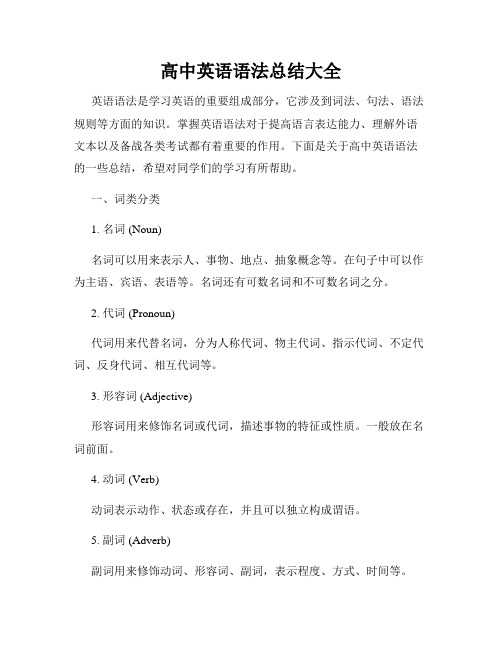
高中英语语法总结大全英语语法是学习英语的重要组成部分,它涉及到词法、句法、语法规则等方面的知识。
掌握英语语法对于提高语言表达能力、理解外语文本以及备战各类考试都有着重要的作用。
下面是关于高中英语语法的一些总结,希望对同学们的学习有所帮助。
一、词类分类1. 名词 (Noun)名词可以用来表示人、事物、地点、抽象概念等。
在句子中可以作为主语、宾语、表语等。
名词还有可数名词和不可数名词之分。
2. 代词 (Pronoun)代词用来代替名词,分为人称代词、物主代词、指示代词、不定代词、反身代词、相互代词等。
3. 形容词 (Adjective)形容词用来修饰名词或代词,描述事物的特征或性质。
一般放在名词前面。
4. 动词 (Verb)动词表示动作、状态或存在,并且可以独立构成谓语。
5. 副词 (Adverb)副词用来修饰动词、形容词、副词,表示程度、方式、时间等。
6. 介词 (Preposition)介词用来表示名词与其他词语之间的关系,常用的有in、on、at、to等。
7. 连词 (Conjunction)连词用来连接词语、短语或句子,分为并列连词、从属连词和连接副词。
8. 冠词 (Article)冠词分为定冠词和不定冠词,用来修饰名词,表示特指和泛指的概念。
9. 数词 (Numeral)数词用来表示数字,分为基数词和序数词。
二、主谓一致主谓一致是指主语与谓语在人称和数上保持一致。
主要涉及到以下几个方面:1. 单数主语与单数谓语动词搭配,复数主语与复数谓语动词搭配。
2. 不可数名词作为主语时,谓语动词使用单数形式。
3. 连词and连接的两个主语为复数,谓语动词使用复数形式。
三、时态和语态1. 一般现在时 (Simple Present Tense)表示现在经常或反复发生的动作、状态或真理等。
2. 一般过去时 (Simple Past Tense)表示过去某个时间发生的动作或状态。
3. 一般将来时 (Simple Future Tense)表示将来要发生的动作或状态。
高中英语语法:代词(共58张PPT)

一、人称代词、物主代词与反身代词
(1)人称代词的基本用法。
归纳
几个人称代词并列时的顺序: 单数并列“二、三、一”, 复数并列“一、二、三” 两性并列“他+她” , 承担责任我在前。 I and he are wrong.我和他都错了。 He and she go to work together.他和她一起去上班。
(1)人称代词的基本用法。 ①做主语 If you want to speak fluent English, you need to listen carefully to native speakers so that you can understand them.如果想讲一口流利的英语,就需要 认真地听母语是英语的人说话,这样你才能理解。 (此句中的三个you分别充当所在句子的主语) Times change, and we change with them.时代总在变,人也在随着变。(we 作change的主语) ②作表语 Who called me just now?谁刚才和我打电话了? It’s him.是他.(him作is的宾语)
一、人称代词、物主代词与反身代词
(2)人称代词的其他用法。 ⑥在谚语和格言中,用he来表示一类人。 He who does not advance loses ground.逆水行舟,不进则退。 (3)it的用法 ①it代指时间、距离、天气、自然现象等。 For example, one evening when it was so warm, I stayed awake on purpose until half past eleven in order to have a good look at the moon by myself.例如,有天晚上天气很 暖和,我故意熬到11点半不睡觉,为的是独自好好欣赏月亮。(it代指天气) ②it代指上文中提到的事物。 We think the Olympic Park is a great place to go because it not only has fantastic stadiums for Olympic Games but also has many beautiful gardens.我们认为奥林匹克公园是 很好的去处,因为那里不仅有奥林匹克运动会使用的大体育场,还有很多美丽的公园。
高中英语家教备课资料 高中英语基础语法第六课:代词

代词是代替名词及起名词作用的短语或句子的词一、人称代词指代人事物的代词。
主语,宾语,表语It:①代替前文已出现的名词;②表示性别、身份等无法确认或说明的人事物;③时间、季节、气候、距离等抽象名词;④形式主语或形式宾语;⑤一些习惯用法,it本身无意义make it成功⑥强调句:it's ..... that ......Working hard makes you succeedIt is working hard that makes you succeedIt is you that working hard makes succeed二、物主代词物主代词是表示所有关系的代词,用来说明某物属于某人或与某人有关。
形容词性物主代词只作定语,名词性物主代词可作主语、宾语、表语、连用of作定语三、反身代词宾语、同位语、表语1、作宾语时,主语和宾语是同一个/群人he enjoy himself只能接反身代词作宾语的特殊及物动词:absent-------absent oneself from activity/...Avail---------avail oneself of 利用Pride---------pride oneself on (doing) sth自豪于2、作表语时,反身代词用来描述感觉、情绪和状态。
Be oneself feel oneself3、作主语或宾语的同位语时,表‘亲自’,用于加强语气,放在被修饰名词后或句末一个名词(或其它形式)对另一个名词或代词进行解释或补充说明,这个名词(或其它形式)就是同位语。
同位语与被它限定的词的格式要一致,并常常紧挨在一起。
同位语除表示其同位成分的全部意义外,还可以表示部分意义。
(考点主要是同位语从句,后续展开)常见用法:by oneself 亲自;独自enjoy oneself 玩得开心come to oneself恢复知觉dress oneself 自己穿衣服devote oneself to致力于speak to oneself 自言自语teach oneself 自学help oneself to 随便吃in oneself 本身固有四、不定代词不明确指代某个人、某个事物、某些人、某些事物的代词(1)some、any的用法(2)few,a few,little,a little的用法(3)other,the other,others,the others,another的用法(4)all,both,none,either,neither的用法注:①each可用干两者、三者或三者以上,而every只用干三者或三者以上②all和each既可单独使用,也可后接名词,还可后接of短语;而every后必须接名词,既不能单独使用也不能后接of短语③不定代词all,every 等与 not 连用时构成部分否定;若要表示完全否定,则需换用 none,neither, no one等。
高中英语代词的用法详解
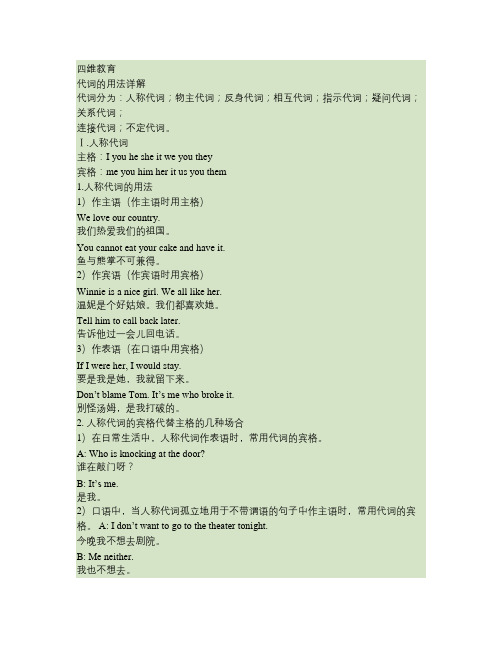
四维教育代词的用法详解代词分为:人称代词;物主代词;反身代词;相互代词;指示代词;疑问代词;关系代词;连接代词;不定代词。
Ⅰ.人称代词主格:I you he she it we you they宾格:me you him her it us you them1.人称代词的用法1)作主语(作主语时用主格)We love our country.我们热爱我们的祖国。
You cannot eat your cake and have it.鱼与熊掌不可兼得。
2)作宾语(作宾语时用宾格)Winnie is a nice girl. We all like her.温妮是个好姑娘。
我们都喜欢她。
Tell him to call back later.告诉他过一会儿回电话。
3)作表语(在口语中用宾格)If I were her, I would stay.要是我是她,我就留下来。
Don’t blame Tom. It’s me who broke it.别怪汤姆,是我打破的。
2. 人称代词的宾格代替主格的几种场合1)在日常生活中,人称代词作表语时,常用代词的宾格。
A: Who is knocking at the door?谁在敲门呀?B: It’s me.是我。
2)口语中,当人称代词孤立地用于不带谓语的句子中作主语时,常用代词的宾格。
A: I don’t want to go to the theater tonight.今晚我不想去剧院。
B: Me neither.我也不想去。
A: I’d like to stay here for another week.我想在这里再呆一周。
B: Me too.我也是。
3)在带as 和than 的比较级后面,许多场合下用代词的宾格。
She knows me as well as him.她像了解他一样了解我。
He is taller than me.他比我高。
4)口语中,当人称代词用于带有强烈感情色彩的句子中作主语且其后不带宾语时,多用代词的宾格。
高中英语语法之代词概述及各类代词用法讲义
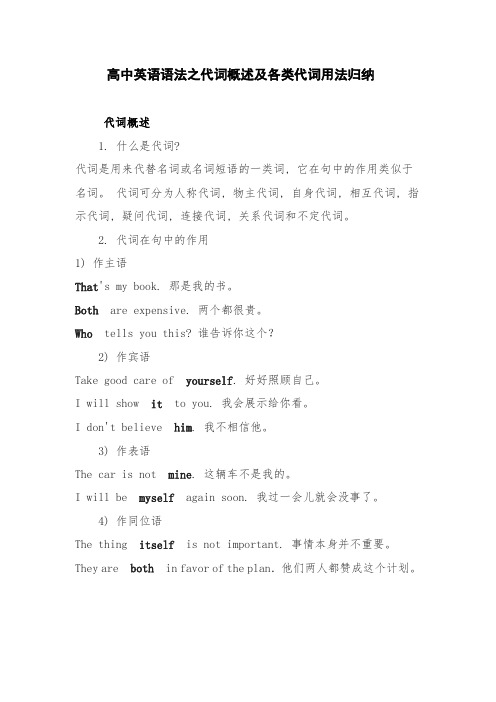
高中英语语法之代词概述及各类代词用法归纳代词概述1. 什么是代词?代词是用来代替名词或名词短语的一类词, 它在句中的作用类似于名词。
代词可分为人称代词, 物主代词, 自身代词, 相互代词, 指示代词, 疑问代词, 连接代词, 关系代词和不定代词。
2. 代词在句中的作用1) 作主语That's my book. 那是我的书。
Both are expensive. 两个都很贵。
Who tells you this? 谁告诉你这个?2) 作宾语Take good care of yourself. 好好照顾自己。
I will show it to you. 我会展示给你看。
I don't believe him. 我不相信他。
3) 作表语The car is not mine. 这辆车不是我的。
I will be myself again soon. 我过一会儿就会没事了。
4) 作同位语The thing itself is not important. 事情本身并不重要。
They are both in favor of the plan.他们两人都赞成这个计划。
5) 作呼语You stand here and wait for the bus. 你站在这儿等公车吧。
Be patient, everyone. 大家都耐心点吧。
6) 作定语That's my glasses. 那是我的眼镜。
I'll buy that umbrella.人称代词1. 人称代词的词汇a) 人称代词主格 (在句中作主语)单数第一人称: I (我)单数第二人称: you (你)单数第三人称: he, she, it (他,她,它)复数第一人称: we(我们)复数第二人称: you(你们)复数第三人称: they (他们/她们/它们)b) 人称代词宾格 (在句中作宾语)单数第一人称: me (我)单数第二人称: you (你)单数第三人称: him, her, it(他,她,它)复数第一人称: us(我们)复数第二人称: you(你们)复数第三人称: them (他们/她们/它们)2. 人称代词在句中的作用1) 作主语I am a student. 我是一名学生。
英语语法代词
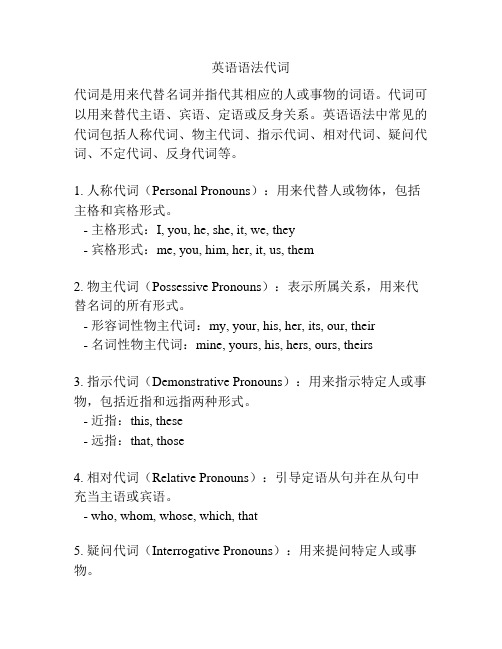
英语语法代词代词是用来代替名词并指代其相应的人或事物的词语。
代词可以用来替代主语、宾语、定语或反身关系。
英语语法中常见的代词包括人称代词、物主代词、指示代词、相对代词、疑问代词、不定代词、反身代词等。
1. 人称代词(Personal Pronouns):用来代替人或物体,包括主格和宾格形式。
- 主格形式:I, you, he, she, it, we, they- 宾格形式:me, you, him, her, it, us, them2. 物主代词(Possessive Pronouns):表示所属关系,用来代替名词的所有形式。
- 形容词性物主代词:my, your, his, her, its, our, their- 名词性物主代词:mine, yours, his, hers, ours, theirs3. 指示代词(Demonstrative Pronouns):用来指示特定人或事物,包括近指和远指两种形式。
- 近指:this, these- 远指:that, those4. 相对代词(Relative Pronouns):引导定语从句并在从句中充当主语或宾语。
- who, whom, whose, which, that5. 疑问代词(Interrogative Pronouns):用来提问特定人或事物。
- who, whom, whose, which, what6. 不定代词(Indefinite Pronouns):指代不确定人或物体的代词。
- some, any, no, all, each, every, few, many, several, someone, anyone, no one, everyone, etc.7. 反身代词(Reflexive Pronouns):表示动作的反身关系。
- myself, yourself, himself, herself, itself, ourselves, yourselves, themselves以上是英语语法中常见的代词,它们在句子中扮演着重要的角色,可以使句子更加简洁明了。
高中英语语法之 代词

高中英语语法—代词一、概念代词是代替名词的词,可分为八类:人称代词、物主代词、指示代词、反身代词、相互代词、疑问代词、不定代词和关系代词等。
1.人称代词1)人称代词的人称、数和格,如下表所示。
2)人称代词有主格和宾格之分。
通常主格作主语,宾格作宾语。
如:I like table tennis. (I作主语)Do you know him?(him作宾语)3)人称代词还可作表语。
作表语时用宾格。
如:---Who’s is knocking at the door?---It’s me. (me 作标语)4)人称代词在than之后与其他人或事物进行比较时,用主格和宾格都可以。
如:He is older than me.He is older than I am.2. 物主代词1)表示所有关系的代词叫物主代词。
物主代词分形容词性物主代词和名词性物主代词,如下表所示。
2)形容词性物主代词的作用相当于形容词,可在句中作定语。
例如:Our teacher is coming to see us.(our作定语)This is her pencil-box.(her作定语)3)名词性物主代词的作用相当于名词,在句中可用作主语、宾语和表语。
Our school is here, and theirs is there.(theirs作主语)--- Is this English-book yours? (yours作表语)--- No. Mine is in my bag.(mine作主语)I've already finished my homework. Have you finished yours?(yours作宾语)3. 指示代词指示代词包括:this,that,these,those。
1) this和these一般用来指在时间或空间上较近的事物或人,that和those则指时间和空间上较远的事物或人,例如:This is a pen and that is a pencil.We are busy these days.In those days the workers had a hard time.2)有时that和those指前面讲到过的事物,this 和these则是指下面将要讲到的事物,例如:I had a cold. That's why I didn't come.What I want to say is this:pronunciation is very important in learning English.3)有时为了避免重复提到的名词,常可用that或those代替,例如:Television sets made in Beijing are just as good as those made in Shanghai.4)this 在电话用语中代表自己,that 则代表对方。
高中英语语法代词 PPT

3、 It is great fun __ surfing on the Internet 、 A、 go B、 to go C、 going
二、物主代词
人称 第一人称
第二人称
分 单数 复数 单数 复数
类
第三人称
单数
复数
形
容 词
my
性
our your your his her its their
ss s
s
s
用法口诀:物主代词两类型,形容词性、名词性。
形容词性作定语, 后面定把名词用。
名词性、独立用, 主宾表语它都充。
【巧学妙记】 形物代词能力差,自己不能来当家。 句子当中作定语,后面要把名词加。 名物代词能力强,自己独来又独往。 句子成分主表宾,后面名词不能跟。
根据汉语填空:
当堂训练
1、The two little girls are crying、
A、 it B、 one C、 that
1.I found ___ very difficult to make progress
in my study 、
A、 it’s
B、 it
C、 that
2、 It __ my father a whole month to go on business 、
England、 轮船要起航了。这就是她第一次去英国。
1、 — Who broke the window? — Not _____、 A、 I B、 he C、 her
2、 Miss Li invited __ have dinner with her 、
A、 me and you B、 you and I C、 you and me
高中英语语法——代词的用法

来代替“形容词性物主代词+名词”的形式。 如:My bag is yellow, her bag is red, his bag is blue
2) 名词性物主代词的句法功能 a. 作主语 如: May I use your pen? Yours works better. b. 作宾语 如:I love my motherland as much as you love
yours. 我爱我的祖国就像你爱你的祖国一样深。 c. 作介词宾语
His cap 意为 The cap is his.
D) 可以说 a friend of mine (ours, yours, hers, his, theirs),=one of my friends;但是不能说 a friend of me (us, you, her, him, them)。
这三种代词都有人称(一、二、三人称) 的变化、数(单、复数)的变化,以及性 (阴性、阳性、中性)的变化。其中,人 称代词除了这三种变化外,还有格(主格、 宾格)的变化。
物主代词又包括两种形式:形容词性物主 代词和名词性物主代词。
特别注意:形容词性物主代词its没有相应 的名词性物主代词。
这三种代词的形式变化表如下
人称 单复数 主 格
宾格
形容词性 名词性 物主代词 物主代词
反身代词
第一 单 数
I
me
人称 复 数
we
us
第二 单 数
高中英语语法知识:代词

高中英语语法知识:代词代词(英文pronoun,简称pron.),是指代名词或一句话的一种词类。
大多数代词具有名词和形容词的功能。
英语中的代词,按其意义、特征及在句中的作用分为:人称代词、物主代词、指示代词、反身代词、相互代词、疑问代词、关系代词、连接代词、不定代词和替代词十种。
人称代词分为主格(如:I, you, he等)和宾格(如:me, you, him)物主代词分为形容性物主代词(如:my, his, your)和名词性物主代词(如:mine, his, yours)指示代词常见的有四个:this这,that那, these这些, those那些反身代词如:myself我自己,himself他自己,themselves他们自己疑问代词用在特殊疑问句中。
有:who, whom, whose, what, which。
如:Who is that boy? What do you like?不定代词如:some一些, many许多, both两个都, everything, everybody等关系代词引导定语从句。
如:This is the boy who won the race.相互代词指each other 与one another,意为“互相”连接代词疑问代词在引导从句时,都称为连接代词,包括who, whom, whose, what, which, whoever,whomever, whichever, whatever,一共九个。
如:It is clear enough what she meant. 她是什么意思很清楚。
(引导主语从句)I don’t care what they think. 他们怎么想我不管。
(引导宾语从句)替代词that,one(单数),ones(复数)。
为避免重复,在一个句子中常用替代词替代前面已经提到过的事物。
高中英语语法大全

高中英语语法:代词的分类代词用来代替名词、名词短语或句子的词称为代词。
代词可分为:人称代词、指示代词、疑问代词、反身代词和不定代词等。
一、人称代词1. 人称代词不仅仅指人,也可以指事或物。
2. 第三人称的人称代词分阳性 he(him) ,阴性 she(her)和中性it(it),复数和宾语形式都只有一个形式 they 和 them,不分性别。
3. 选用什么人称代词,取决于所要代替的名词。
在数和性上要与所代替的名词保持一致。
二、物主代词物主代词是用来表示所有关系的,分为形容词性物主代词和名词性物主代词两种。
形容词性物主代词放在名词前作定语,相当于形容词;名词性物主代词相当于“形容词性物主代词+名词” ,相当于名词,可以作主语、表语或宾语。
物主代词的用法:(1)形容词性物主代词放在名词前作定语。
例如: His pencil box is on the desk. This is our school.(2)名词性物主代词作名词用,本身就相当于“形容词性物主代词+名词” ,因此,后面不可再加名词。
作主语:Richard’s sc hool bag is blue and mine is black. 理查德的书包是蓝色的,我的书包是黑色的。
(mine=my school bag)作表语:It’s his. 这是他的(东西) 。
作宾语: He borrows your dictionary and you may borrow mine. 他借你的字典,你可以借我的。
(作及物动词的宾语)“of+名词性物主代词”可以放在名词后作定语,表示强调: He is a friend of mine. 他是我的一个朋友。
注意:试比较下面两句句子: This is a photo of mine. 这是我的一张照片。
(照片是我拥有的,但不一定照的是我本人)This is a photo of me. 这是一张我本人的照片。
高考英语语法总复习4人称代词物主代词反身代词课件

代词考点
人称代词 物主代词 反身代词 指示代词 疑问代词 不定代词
指代名词或一句话的词类
代词
(1)人称代词的分类
1.人称代词 (2)人称代词的用法
(3)人称代词的排列顺序
(1)人称代词的分类
数 人称
格 第一人称 第二人称 第三人称
主格
单数
宾格
I
me
you
you
he,she,it
C.me; one
D.me, it
(1)反身代词的分类
3.反身代词 (2)反身代词的用法
(3)反身代词固定搭配
(1)反身代词的分类
人称 数
单数
复数
第一人称
myself ourselves
第二人称
yourself yourselves
第三人称
himself,herself,itself themselves
让我迎接挑战,我会欣然面对它。
2.人称代词单独使用或在没有谓语动词的句子中时通常用宾格
Why me?I’ve been working for two weeks on end.
为什么是我?我已经连续上了两周的班了。
-Glad to see you. -Me too.
很高兴见到你。 我也是。
(3)人称代词的排列顺序
him,her,it
复数
主格
宾格
we
us
you
you
they
them
(2)人称代词的用法
1.人称代词作主语时,用主格;作动词或介词宾语时,用宾 格;作表语时,用主格,但在口语中常用宾格
Give me(宾语) a challenge,and I(主语) will meet it(宾语) with joy.
高中英语语法代词归纳总结

高中英语语法代词归纳总结代词是英语语法中的一种词类,用于代替名词或名词短语,起到简化语言或避免重复的作用。
在高中英语学习中,掌握代词的使用非常重要,因此本文将对高中英语语法中的代词进行归纳总结。
以下是代词的不同类型及其用法:一、人称代词人称代词分为主格和宾格两种形式,用于代替人或人物。
主格人称代词用于作主语,而宾格人称代词用于作宾语或介词后的宾语。
1. 主格人称代词:I, you, he, she, it, we, they例如:- I am a student.(我是学生。
)- He is reading a book.(他正在读一本书。
)2. 宾格人称代词:me, you, him, her, it, us, them例如:- She called me yesterday.(她昨天给我打电话。
)- They invited us to their wedding.(他们邀请我们参加他们的婚礼。
)二、物主代词物主代词用于表示所属关系或所有权。
1. 形容词性物主代词:my, your, his, her, its, our, their例如:- This is my book.(这是我的书。
)- Is this your pen?(这是你的笔吗?)2. 名词性物主代词:mine, yours, his, hers, its, ours, theirs例如:- The blue car is mine.(那辆蓝色的车是我的。
)- Is this book yours or mine?(这本书是你的还是我的?)三、反身代词反身代词用于表示动作的反身或强调。
1. 单数形式:myself, yourself, himself, herself, itself例如:- I can do it myself.(我可以自己做。
)- She hurt herself while playing basketball.(她在打篮球时受伤了。
高中英语语法-代词

3)other, the other, another, others, the others的区别 用 法 单数 不定 another 另一个 代名词 复数 others 其他人 单数 another (boy) 另一个 the other (boy) 另一个男 孩 形容词 复数 other (boys) 其他男孩 the other (boys) 其余那些男 孩
5)all和both的用法 ①all指三者以上,或不可数的东西。谓语动词既可以用 单数,也可以用作复数。在句中作主语、表语、宾语、 同位语和定语。 All of us like Mr Pope.(作主语) 复数 All the water has been used up. (作主语) 单数 We all like Mr Pope. (作同位语)
4)such, same的用法: such(如此的)和same(同样的)也是指示代词,其 单、复数的形式相同: They had never seen such a beautiful city before. We are not talking about the same thing.
总结
6)人称代词it除了可以指人指物之外,还可以表示“时 间、天气、温度、距离、情况”等含义,此外还可以作 “非人称代词”使用, it可以替代句中的不定式或从句 等,充当形式主语或形式宾语。 --What’s the weather like today? -- It’s fine. It took him three days to clean his house. We found it very difficult to learn English well.
7)人称代词的其他用法 (1)报刊和文章的作者,在发表观点时,常用we代替I (同样地,用our代替代my)。 We believe China will become stronger in the future. (2)用she来代替国家、城市、船舶、飞机、大地、月 亮等,以表示亲切和爱护。 That's the picture of our city; she has changed a lot. (3)it有时可用来代替小孩(child)和婴儿(baby) The child smiled when it saw its mother. (4)they可用来代替一般的人,特别在“they say”中 比较常用。 They say it's going to rain tomorrow.
【高中英语语法】代词
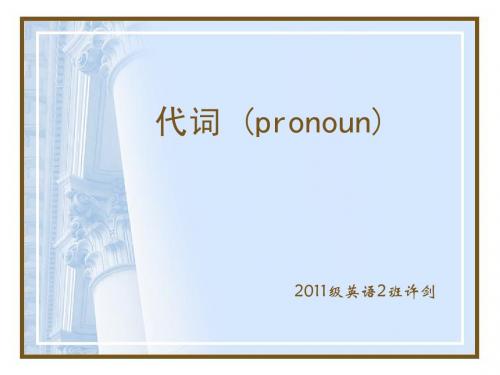
• ③作表语人称代词一般用宾格, 但在强调句型中,被强调部分 代词的格不变。 • I met her in the hospital. → • It was I who met her in the hospital.
• ④在比较级的句子中than、as 后用主格、宾格都可以。如: • He is taller than me (I). • 但在下列句中有区别: • I like Jack as much as her.=I like both Jack and her. • I like Jack as much as she.=I like Jack and she likes him, too.
• ③在期待对方回答yes 时,some用 在表示请求或邀请的问句中。 • Would you like some bananas?(邀 请) • Mum, could you give me some money?(请求)
• ④ some 用于否定句表示部分否定。 • I don’t know some of the students.(宾 语) • some和any在句中还可作状语,作副词。 some意为“大约”相当于“about”,而 any则表示程度,意为“稍,丝毫”。 如: • There are some 300 workers on strike. • Do you feel any better today?
• ②句子中代词作宾语或宾语补足语时, 与所替代的名词在人称、数、格在意义 上一般要保持前后一致。 • The thief was thought to be he. (the thief是主格,故用he代替) • They took me to be her. • (me是宾格,故用her替代)
高中英语语法 代词
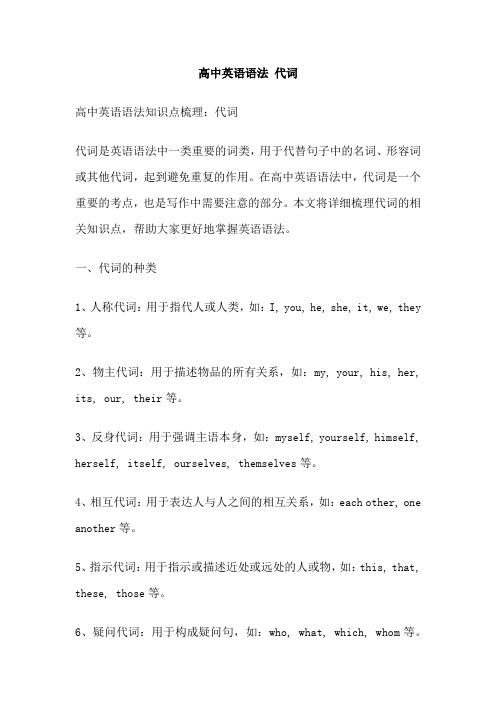
高中英语语法代词高中英语语法知识点梳理:代词代词是英语语法中一类重要的词类,用于代替句子中的名词、形容词或其他代词,起到避免重复的作用。
在高中英语语法中,代词是一个重要的考点,也是写作中需要注意的部分。
本文将详细梳理代词的相关知识点,帮助大家更好地掌握英语语法。
一、代词的种类1、人称代词:用于指代人或人类,如:I, you, he, she, it, we, they 等。
2、物主代词:用于描述物品的所有关系,如:my, your, his, her, its, our, their等。
3、反身代词:用于强调主语本身,如:myself, yourself, himself, herself, itself, ourselves, themselves等。
4、相互代词:用于表达人与人之间的相互关系,如:each other, one another等。
5、指示代词:用于指示或描述近处或远处的人或物,如:this, that, these, those等。
6、疑问代词:用于构成疑问句,如:who, what, which, whom等。
7、关系代词:用于引导关系从句,如:that, which, who, whom, whose 等。
二、代词的用法1、人称代词:在句子中作主语或宾语,替代名词、名词短语或句子。
2、物主代词:在句子中作定语,限定名词的范围或种类。
3、反身代词:在句子中作宾语或同位语,表示主语和宾语为同一人或物。
4、相互代词:在句子中作宾语或介词宾语,表示人与人之间的相互关系。
5、指示代词:在句子中作主语、宾语或表语,起指示或替代作用。
6、疑问代词:在句子中引导特殊疑问句,就某个事物、人或代词进行提问。
7、关系代词:在句子中引导关系从句,连接主句和从句,表达两者之间的关系。
三、注意事项1、代词的准确使用:在句子中选用合适的代词替代相应的名词、形容词或其他代词,避免歧义和误解。
2、代词的先行词:在使用关系从句时,要注意先行词的选择和使用,确保从句与主句之间的逻辑关系清晰。
- 1、下载文档前请自行甄别文档内容的完整性,平台不提供额外的编辑、内容补充、找答案等附加服务。
- 2、"仅部分预览"的文档,不可在线预览部分如存在完整性等问题,可反馈申请退款(可完整预览的文档不适用该条件!)。
- 3、如文档侵犯您的权益,请联系客服反馈,我们会尽快为您处理(人工客服工作时间:9:00-18:30)。
• (2) 两个以上的人称代词并列, 其次序排列原则:
• ①在并列主语中,“I”, “me” 总是放在最后,排列顺序为:二 三 一(人称),如:
• You ,she and I will be in charge of the case.
• The thief was thought to be he. (the thief是主格,故用he代替)
• They took me to be her. • (me是宾格,故用her替代)
• ③作表语人称代词一般用宾格, 但在强调句型中,被强调部分 代词的格不变。
• I met her in the hospital. →
代词 (pronoun)
xxx
• 代词分为九类:人称代词、物 主代词、反身代词、相互代词、 指示代词、疑问代词、连接代 词、不定代词、关系代词。大 多数代词具有名词和形容词的 作用。
• 1、人称代词 • (1)人称代词作主语用主格,作宾语、
表语用宾格,但应注意以下4种情况: • ①作主语的人称代词如果孤立地使用于
• (3)某些固定结构中常用定冠词代替物主代词。
• 如: take sb. by the arm
•
be wounded in the leg.
•
hit sb. in the face
•
Байду номын сангаас
pat sb. on the shoulder/on the head
• 3.反身代词
• (1)反身代词的语法功能:宾 语、表语、主语或宾语的同位 语。
• One should not live only for oneself. • of oneself 自然地,自动地
• The door opened of itself. • by oneself 独自地,靠自己地
• His father lives by himself in the village.
• It was I who met her in the hospital.
• ④在比较级的句子中than、as 后用主格、宾格都可以。如:
• He is taller than me (I). • 但在下列句中有区别:
• I like Jack as much as her.=I like both Jack and her.
• in oneself 就其本身或本性而言
• This wood is hard in itself. • to oneself 独自占有或享用
• When he has dinner in a restaurant, he likes a table to himself.
• 4.相互代词(each other, one another)
• In those days they could not go to school.
• ②this常指后面要讲到的事物, 有启下的作用;that则指前面讲 到过的事物,有承上的作用。
• I want to tell you this: the English party will be held on Saturday afternoon.
• Mr. Zhang asked Li Hua and me to help him.
• ②第三人称,男女两性并 用,男先女后。
• He and she still don’t agree to the plan.
• (3)几个人称代词的特殊用法。 • ①we/you(口语)常用来泛指一
般人。 • ②she可以代表国家、船只、
• He hurt his leg yesterday. That’s why he didn’t come.
• ③为了避免重复,常用that或 those代替前面已提过的名词。
• The weather of Beijing is colder than that of Nanjing.
• The ears of a rabbit are longer than those of a fox.
大地、月亮等。
• The “Titanic” was the largest, wasn’t she?
• 2.物主代词
• (1)名词和形容词性物主代词各自的语法功能。
• (2)one’s own…=...of one’s own句式的转换。
• This is my own room. = This is the room of my own.
• 相互代词无人称、数和格的区 别,在句中作宾语。其所有格 分别为each other’s 、one another’s ,作定语。
• 一般来说,each other指两者 之间,one another指三者或三 者以上之间,但在现代英语中 已无明显区别。
• 5.指示代词(this, that , these, those, such, same)
无谓语动词的句子中,或在这种句子中与 动词不定式连用,常用宾格。
• —Does any of you know where Tom lives? —Me.
• What! Me (to) go with him? No!
• ②句子中代词作宾语或宾语补足语时, 与所替代的名词在人称、数、格在意义 上一般要保持前后一致。
• 指示代词具有形容词和代 词两种词性,在句子中可以作 定语、主语、宾语或表语等。
• (1)指示代词this和that的区别。 • ①this (these)一般指时间或空间
上较近的人或物;that (those)常 指时间或空间较远的人或物。
• This is my desk and that is yours.
• (2)反身代词和某些动词连用, 构成固定短语。
• enjoy oneself, feel oneself, make oneself at home, make oneself understood, help oneself to sth.
• (3)反身代词还可用于某些成语中。 • for oneself 为自己
